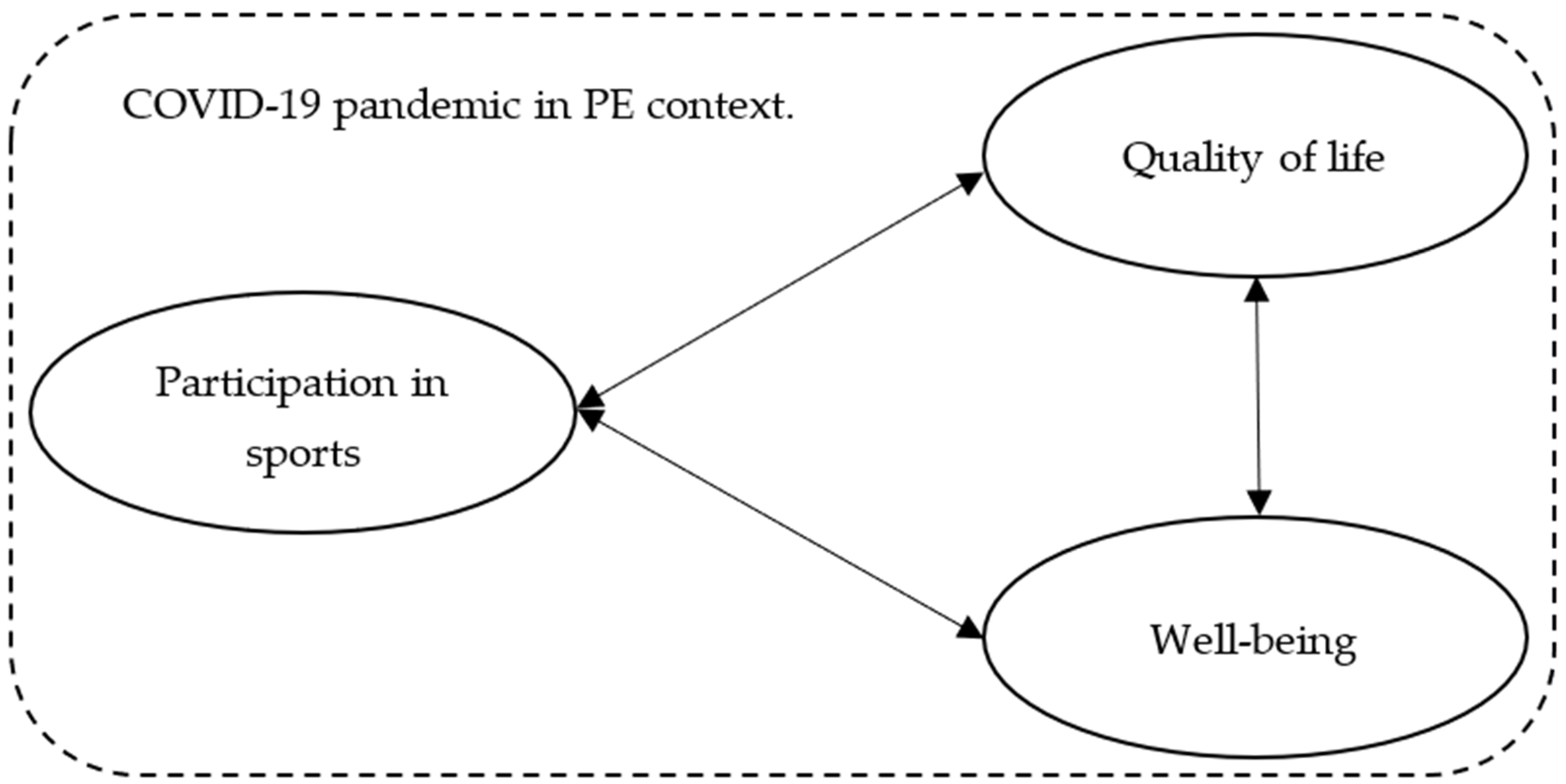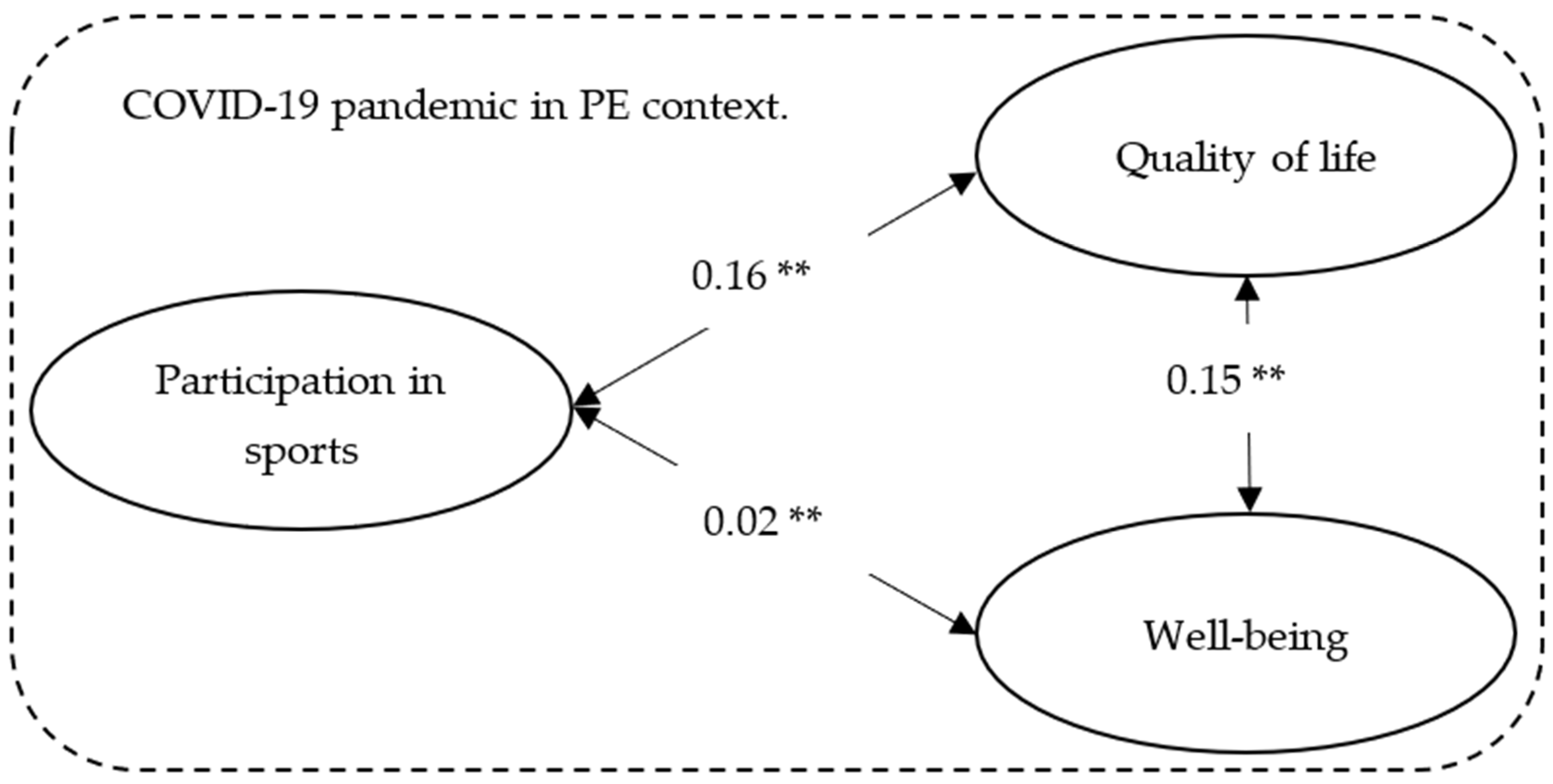The Impact of Physical Education Classes on Health and Quality of Life during the COVID-19
Abstract
:1. Introduction
2. Materials and Methods
2.1. Participants
2.2. Measures
2.2.1. Participation in Sports
2.2.2. Well-Being
2.2.3. Quality of Life
2.3. Data Analysis
3. Results
3.1. Participants’ Demographic Characteristics
3.2. COVID-19′s Effect on the Physical Education Course between Physical Fitness, Quality of Life, Attitude, and Well-Being in College Students
4. Discussion
Limitations and Future Directions
5. Conclusions
Author Contributions
Funding
Institutional Review Board Statement
Informed Consent Statement
Data Availability Statement
Acknowledgments
Conflicts of Interest
References
- Wong, A.Y.Y.; Ling, S.K.K.; Louie, L.H.T.; Law, G.Y.K.; So, R.C.H.; Lee, D.C.W.; Yau, F.C.-F.; Yung, P.S.H. Impact of the COVID-19 pandemic on sports and exercise. Asia-Pacific J. Sports Med. Arthrosc. Rehabil. Technol. 2020, 22, 39–44. [Google Scholar] [CrossRef]
- Booth, M. Assessment of physical activity: An international perspective. Res. Q. Exerc. Sport 2020, 71, 114–120. [Google Scholar] [CrossRef] [PubMed]
- Taylor, I.M.; Lonsdale, C. Cultural differences in the relationships among autonomy support, psychological need satisfaction, subjective vitality, and effort in British and Chinese physical education. J. Sport Exerc. Psychol. 2010, 32, 655–673. [Google Scholar] [CrossRef] [PubMed] [Green Version]
- Ryan, R.M.; Deci, E.L. Self-determination theory and the facilitation of intrinsic motivation, social development, and well-being. Am. Psychol. 2020, 55, 68–78. [Google Scholar] [CrossRef]
- Ntoumanis, N.; Standage, M. Motivation in physical education classes: A self-determination theory perspective. School Field 2009, 7, 194–202. [Google Scholar] [CrossRef] [Green Version]
- Standage, M.; Gillison, F.B.; Ntoumanis, N.; Treasure, D.C. Predicting students’ physical activity and health-related well-being: A prospective cross-domain investigation of motivation across school physical education and exercise settings. J. Sport Exerc. Psychol. 2012, 34, 37–60. [Google Scholar] [CrossRef] [Green Version]
- Ryan, R.M.; Huta, V.; Deci, E.L. Living well: A self-determination theory perspective on eudaimonia. J. Happiness Stud. 2008, 9, 139–170. [Google Scholar] [CrossRef]
- Patall, E.A.; Cooper, H.; Robinson, J.C. The effect of choice on intrinsic motivation and related outcomes: A meta-analysis of research findings. Psychol. Bull. 2008, 134, 270–300. [Google Scholar] [CrossRef]
- Cox, A.; Williams, L. The roles of perceived teacher support, motivational climate, and psychological need satisfaction in students’ physical education motivation. J. Sport Exerc. Psychol. 2008, 30, 222–239. [Google Scholar] [CrossRef] [PubMed] [Green Version]
- Wang, F.J.; Cheng, C.F.; Chen, M.Y.; Sum, K.W.R. Temporal precedence of physical literacy and basic psychological needs satisfaction: A cross-lagged longitudinal analysis of university students. Int. J. Environ. Res. Public Health 2020, 17, 4615. [Google Scholar] [CrossRef]
- Hayes, A.F. Introduction to Mediation, Moderation, and Conditional Process Analysis: A Regression-Based Approach, 2nd ed.; The Guilford Press: New York, NY, USA, 2018. [Google Scholar]
- Boothby, J.; Tungatt, M.F.; Townsend, A.R. Ceasing participation in sports activity: Reported reasons and their implications. J. Leis. Res. 1981, 13, 1–14. [Google Scholar] [CrossRef]
- Campbell, A. Subjective measures of well-being. Am. Psychol. 1976, 31, 117–124. [Google Scholar] [CrossRef] [PubMed]
- Edmondson, A. Psychological safety and learning behavior in work teams. Adm. Sci. Q. 1999, 44, 350–383. [Google Scholar] [CrossRef] [Green Version]
- Burckhardt, C.S.; Anderson, K.L. The Quality of Life Scale (QOLS): Reliability, validity, and utilization. Health Qual. Life Outcomes 2003, 1, 1–7. [Google Scholar]
- West, S.G.; Finch, J.F.; Curran, P.J. Structural equation models with nonnormal variables: Problems and remedies. In Structural Equation Modeling: Concepts, Issues and Applications; Hoyle, R.H., Ed.; Sage: Newbury Park, CA, USA, 1995; pp. 56–75. [Google Scholar]
- Chou, C.P.; Bentler, P.M. Estimates and tests in structural equation modelling. In Structural Equation Modeling: Concepts, Issues and Applications; Hoyle, R.H., Ed.; Sage: Thousand Oaks, CA, USA, 1995; pp. 37–55. [Google Scholar]
- Burns, R.D.; Fu, Y.; Podlog, L.W. School-based physical activity interventions and physical activity enjoyment: A meta-analysis. Prev. Med. 2017, 103, 84–90. [Google Scholar] [CrossRef]
- Thorburn, M.; Gray, S.; O’Connor, J. Creating thriving and sustainable futures in physical education, health and sport. Sport, Educ. Soc. 2019, 24, 550–557. [Google Scholar] [CrossRef] [Green Version]
- Vallerand, R.J. A hierarchical model of intrinsic and extrinsic motivation in sport and exercise. In Advances in Motivation in Sport and Exercise; Roberts, G.C., Ed.; Human Kinetics: Champaign, IL, USA, 2001; pp. 263–320. [Google Scholar]
- Yli-Piipari, S.; John Wang, C.K.; Jaakkola, T.; Liukkonen, J. Examining the Growth Trajectories of Physical Education Students’ Motivation, Enjoyment, and Physical Activity: A Person-Oriented Approach. J. Appl. Sport Psychol. 2012, 24, 401–417. [Google Scholar] [CrossRef]
- Wang, C.; Chen, P.; Zhuang, J. A national survey of physical activity and sedentary behavior of Chinese city children and youth using accelerometers. Res. Q. Exerc. Sport 2013, 84, 12–28. [Google Scholar] [CrossRef]
- Chen, P. Physical activity, physical fitness, and body mass index in the Chinese child and adolescent populations: An update from the 2016 Physical Activity and Fitness in China—The Youth Study. J. Sport Health Sci. 2017, 6, 381–383. [Google Scholar] [CrossRef] [PubMed]
- Liu, Y.; Tang, Y.; Cao, Z.; Zhuang, J.; Zhu, Z.; Wu, X.; Wang, L.; Cai, Y.; Zhang, J.; Chen, P. Results From China’s 2018 Report Card on Physical Activity for Children and Youth. J. Phys. Act. Health 2018, 15, 333–334. [Google Scholar] [CrossRef]
- Wang, L.; Tang, Y.; Luo, J. School and community physical activity characteristics and moderate-to-vigorous physical activity among Chinese school-aged children: A multilevel path model analysis. J. Sport Health Sci. 2017, 6, 416–422. [Google Scholar] [CrossRef] [PubMed]
- Fairclough, S.; Stratton, G. Improving health-enhancing physical activity in girls’ physical education. Health Educ. Res. 2005, 20, 448–457. [Google Scholar] [CrossRef] [Green Version]
- Hills, A.P.; Dengel, D.R.; Lubans, D.R. Supporting Public Health Priorities: Recommendations for Physical Education and Physical Activity Promotion in Schools. Prog. Cardiovasc. Dis. 2015, 57, 368–374. [Google Scholar] [CrossRef] [PubMed] [Green Version]
- Maugeri, G.; Castrogiovanni, P.; Battaglia, G.; Pippi, R.; D’Agata, V.; Palma, A.; Di Rosa, M.; Musumeci, G. The impact of physical activity on psychological health during COVID-19 pandemic in Italy. Heliyon 2020, 6, e04315. [Google Scholar] [CrossRef] [PubMed]
- Dwyer, M.J.; Pasini, M.; De Dominicis, S.; Righi, E. Physical activity: Benefits and challenges during the COVID-19 pandemic. Scand. J. Med. Sci. Sports 2020, 30, 1291. [Google Scholar] [CrossRef]
- Hammami, A.; Harrabi, B.; Mohr, M.; Krustrup, P. Physical activity and coronavirus disease 2019 (COVID-19): Specific recommendations for home-based physical training. Manag. Sport Leis. 2020, 1–6, in press. [Google Scholar] [CrossRef]
- Pieh, C.; Budimir, S.; Probst, T. The effect of age, gender, income, work, and physical activity on mental health during coronavirus disease (COVID-19) lockdown in Austria. J. Psychosom. Res. 2020, 136, 110186. [Google Scholar] [CrossRef]
- Whitehead, M. Stages in physical literacy journey. J. Sport Sci. Phys. Educ. 2013, 65, 52–56. [Google Scholar]
- Tremblay, M.; Lloyd, M. Physical literacy measurement: The missing piece. Phys. Health Educ. J. 2010, 76, 26–30. [Google Scholar]
- Yang, W.; Wong, S.H.S.; Sum, R.K.W.; Sit, C.H.P. The association between physical activity and mental health in children with special educational needs: A systematic review. Prev. Med. Rep. 2021, 23, 101419. [Google Scholar] [CrossRef]
- Wendtlandt, M.; Wicker, P. The effects of sport activities and environmentally sustainable behaviors on subjective well-being: A comparison before and during COVID-19. Front. Sports Act. Living 2021, 3, 1–14. [Google Scholar] [CrossRef]
- Biddle, S.J.; Ciaccioni, S.; Thomas, G.; Vergeer, I. Physical activity and mental health in children and adolescents: An updated review of reviews and an analysis of causality. Psychol. Sport Exerc. 2019, 42, 146–155. [Google Scholar] [CrossRef]
- Kapsal, N.J.; Dicke, T.; Morin, A.J.; Vasconcellos, D.; Maïano, C.; Lee, J.; Lonsdale, C. Effects of physical activity on the physical and psychosocial health of youth with intellectual disabilities: A systematic review and meta-analysis. J. Phys. Act. Health 2019, 16, 1187–1195. [Google Scholar] [CrossRef]
- Kinder, C.J.; Gaudreault, K.L.; Simonton, K. Structured and Unstructured Contexts in Physical Education: Promoting Activity, Learning and Motivation. J. Phys. Educ. Recreat. Danc. 2020, 91, 30–35. [Google Scholar] [CrossRef]
- Sallis, J.F.; Prochaska, J.J.; Taylor, W.C. A review of correlates of physical activity of children and adolescents. Med. Sci. Sports Exerc. 2000, 32, 963–975. [Google Scholar] [CrossRef]
- Brand, R.; Timme, S.; Nosrat, S. When pandemic hits: Exercise frequency and subjective well-being during COVID-19 pandemic. Front. Psychol. 2020, 11, 2391. [Google Scholar] [CrossRef] [PubMed]
- Teare, G.; Taks, M. Exploring the impact of the COVID-19 pandemic on youth sport and physical activity participation trends. Sustainability 2021, 13, 1744. [Google Scholar] [CrossRef]
- Warburton, D.E.; Bredin, S.S. Health benefits of physical activity: A systematic review of current systematic reviews. Curr. Opin. Cardiol. 2017, 32, 541–556. [Google Scholar] [CrossRef] [PubMed]
- Rasciute, S.; Downward, P. Health or happiness? What is the impact of physical activity on the individual? Kyklos 2010, 63, 256–270. [Google Scholar] [CrossRef]
- Hopkins, W.G. Measures of Reliability in Sports Medicine and Science. Sports Med. 2000, 30, 1–15. [Google Scholar] [CrossRef] [Green Version]
- Caputo, E.L.; Reichert, F.F. Studies of physical activity and COVID-19 during the pandemic: A scoping review. J. Phys. Act. Health 2020, 17, 1275–1284. [Google Scholar] [CrossRef] [PubMed]






| Variables | M | SD | Category | Frequency | Cumulative % |
|---|---|---|---|---|---|
| Gender | 1.68 | 0.47 | Male | 328 | 32.4% |
| Female | 683 | 67.6% | |||
| Grade | 2.00 | 0.09 | Year 1 | 3 | 0.3% |
| Year 2 | 1002 | 99.1% | |||
| Year 3 | 6 | 0.6% | |||
| Participated on interscholastic sports teams | Yes | 210 | 20.8% | ||
| No | 801 | 79.2% | |||
| Perceived atmosphere of sport | Not good | 55 | 5.4% | ||
| Ok | 810 | 80.1% | |||
| Very good | 146 | 14.4% | |||
| Exercise frequency | Regularly exercise | 224 | 22.2% | ||
| Not regularly exercise | 787 | 77.8% | |||
| Well-being | 3.52 | 0.46 | |||
| Quality of life | 3.27 | 0.27 |
| Source | SS | df | MS | F | Scheffe’s |
|---|---|---|---|---|---|
| Difference participations | 0.03 | 1 | 0.00 | 1.61 | |
| Error | 72.59 | 1009 | 0.72 | ||
| Amounts | 72.59 | 1010 | |||
| Difference times | 0.03 | 1 | 0.03 | 0.46 | |
| Error | 72.56 | 1009 | 0.07 | ||
| Amounts | 72.59 | 1010 |
| Variables | Participation in Sports | Well-Being | Quality of Life |
|---|---|---|---|
| 1. Participation in sports | - | ||
| 2. Well-being | 0.02 ** | - | |
| 3. Quality of life | 0.16 ** | 0.15 ** | - |
| Variables | B | SE | t | R2 |
|---|---|---|---|---|
| 0.03 *** | ||||
| Participation in sports - > Quality of life | 0.92 | 0.02 | 5.06 | |
| 0.02 *** | ||||
| Participation in sports - > Well-being | 0.25 | 0.05 | 4.69 | |
Publisher’s Note: MDPI stays neutral with regard to jurisdictional claims in published maps and institutional affiliations. |
© 2021 by the authors. Licensee MDPI, Basel, Switzerland. This article is an open access article distributed under the terms and conditions of the Creative Commons Attribution (CC BY) license (https://creativecommons.org/licenses/by/4.0/).
Share and Cite
Fang, J.-D.D.; Teng, P.-C.; Wang, F.-J. The Impact of Physical Education Classes on Health and Quality of Life during the COVID-19. Appl. Sci. 2021, 11, 8813. https://doi.org/10.3390/app11198813
Fang J-DD, Teng P-C, Wang F-J. The Impact of Physical Education Classes on Health and Quality of Life during the COVID-19. Applied Sciences. 2021; 11(19):8813. https://doi.org/10.3390/app11198813
Chicago/Turabian StyleFang, Jiceh-Der Dong, Pi-Cheng Teng, and Fong-Jia Wang. 2021. "The Impact of Physical Education Classes on Health and Quality of Life during the COVID-19" Applied Sciences 11, no. 19: 8813. https://doi.org/10.3390/app11198813
APA StyleFang, J.-D. D., Teng, P.-C., & Wang, F.-J. (2021). The Impact of Physical Education Classes on Health and Quality of Life during the COVID-19. Applied Sciences, 11(19), 8813. https://doi.org/10.3390/app11198813






